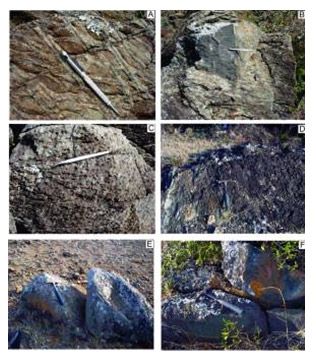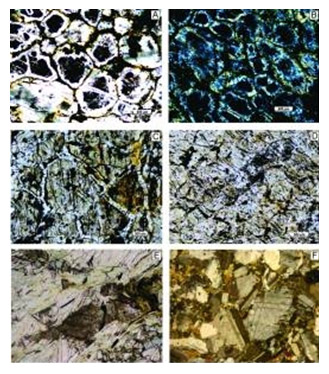Basic Science
| Title | Plume-Arc interaction and evolution of the Holenarsipur Nucleus, Karnataka |
|---|---|
| Participants | M. Alam Siddiqui and M. Ram Mohan |
| Sponsoring Agency | DST under FASTTRACK scheme |
Work Description:
Detailed field and petrographic studies were carried out in the central part of Holenarsipur belt (HNB) of western Dharwar Craton. A massive anorthosite body is identified at the top of a sequence, where the serpentinised peridotite and meta-pyroxenite are exposed at the bottom and middle of the sequence. The weathering and alteration is conspicuous at outcrop scale, and is evident on thin section scale. The ultramafic rock association is traversed by mm to cm scale veins propagated in the network form. This unit exhibits two sets of joints perpendicular to each other and the whole rock is fractured, along these fractures, fluid circulation occurred leading to serpentinization (Fig.24.1A). Another variant of ultramafic rock that is layered; rich in magnetite, wherein the thin veins of secondary magnetite crosscut the whole lithology (Fig.24.1B). Further north, another variant of ultramafic rock is exposed showing hobnail type weathering pattern typical to that of the dunite (Fig.24.1C). Adjacent to this unit green coloured rock is found which is composed of chlorite (Fig.24.1E). On the extreme northern part, these ultramafics are traversed by later magnesite veins. Magnesite occurs as veins, colourless to white in colour with perfect two sets of cleavage (Fig.24.1D). In general, magnesia-rich olivine (forsterite) composition favours production of magnetite from peridotite while the iron-rich olivine (fayalite) favours the production of magnesite-magnetite-silica composition. To further north, a massive anorthosite/ anorthositic gabbro body is identified for the first time. This is the coarse grained, light grey coloured unit exhibiting typical hollow type weathering pattern, similar to the major anorthosite unit that occurs in the southern part of HNB (Fig.24.1F).
The basal unit is composed of olivine pseudomorph showing adcumulate texture although the unit is completely serpentinized (Fig.24.2A). The rock is composed of serpentine (lizardite+antigorite), talc, and magnetite (Fig.24.2B). The mesh texture is evident in the olivine domain and the rock is dunite (Fig.24.2C). Long prismatic orthopyroxene found in association with olivine pseudomorph as a cumulus phase and showing bastite texture (serpentine after pyroxene) (Fig.24.2D). The pyroxinite unit is completely altered and is composed of chlorite (clinochlore), amphibole and relict clinopyroxene (Fig.24.2E). Anorthosite is composed of coarse grained, undeformed plagioclase and amphibole showing orthocumulate texture (Fig.24.2F).
The field relationships and petrographic characteristics suggest that at least this part of the Holenarsipur belt is an intrusive complex which had undergone in situ differentiation, thus manifest magma chamber processes.

Fig.24.2:
Field photographs from the central part of Holenarsipur belt

Fig.24.1:
Microphotographs of various lithounits in the central part of Holenarsipur belt